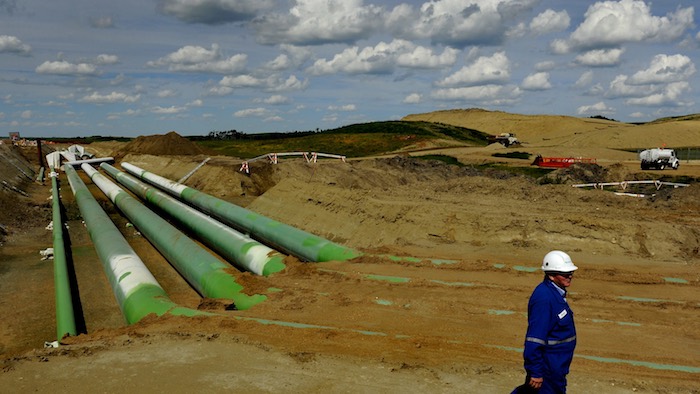Alberta
Cancelling Keystone XL cost thousands of jobs and billions in GDP: U.S. government report

Keystone facility at Hardisty, Alberta. Photo courtesy Getty Images
From the Canadian Energy Centre Ltd.
Politicians, Indigenous leaders, and labour unions criticized the cancellation for the significant consequences it could have for both Canada and the United States
There is no doubt that Keystone XL’s cancellation was a massive gut punch to Canada and its oil and gas industry. Now the analysis is out showing the impact it had on the United States.
Just a sliver over two years ago the U.S. government nixed the pipeline project which would have added an additional 830,000 barrels of oil per day into the U.S.
The pipeline, which was expected to be complete in 2023, would have provided thousands of jobs and billions in economic activity. In December, the U.S. Department of Energy released its congressionally mandated report on the matter, and it’s now known approximately how many jobs and billions of dollars were foregone due to the cancellation.
The highlighted impacts in the report show that about 20,000 potential construction jobs per year over a two-year period were lost.
The nixing of the project also had a direct impact on the U.S. GDP with a loss of $3.4 billion. Wages were also impacted, with an estimated loss of $2.05 billion in potential earnings.
While there have not been any government numbers released for Canadian job losses, TC Energy said at the time of the cancellation that 1,000 workers would be laid off due to the announcement. It was a missed opportunity to lower costs for U.S. consumers, according to the American Petroleum Institute. Indigenous groups were also impacted by the cancellation.
Dale Swampy, president of the National Coalition of Chiefs noted that “It’s quite a blow to the First Nations that are involved right now in working with TC Energy to access employment training and contracting opportunities.”
Natural Law Energy, an Indigenous-owned energy company, had signed an agreement to invest a $1 billion equity stake in the pipeline. This would have had the potential to create jobs and economic opportunity for Indigenous communities, Natural Law Energy said. More than $600 million in supply and employment agreements for Indigenous-owned companies were expected to come from the project’s construction.
While celebrated by many environmental groups, the decision to cancel Keystone XL was controversial on both sides of the border. Politicians, Indigenous leaders, and labour unions criticized the cancellation for the significant consequences it could have for both Canada and the United States.
Teamsters general president Jim Hoffa’s statement strongly encouraged the U.S. government to reconsider the decision. “This executive order doesn’t just affect U.S. Teamsters; it hurts our Canadian brothers and sisters as well who work on this project. It will reduce good-paying union jobs that allow workers to provide a middle-class standard of living to their families.”
Terry O’Sullivan, general president of the Laborers’ International Union of North America said, “By blocking this 100 percent union project, and pandering to environmental extremists, a thousand union jobs will immediately vanish, and 10,000 additional jobs will be foregone.”
The United States is the world’s largest importer of oil, and Canada is its top supplier. America will continue to rely on oil imports, according to the U.S. Energy Information Administration. Absent Keystone XL, imports will come increasingly from other countries that may not have the same environmental and human rights standards as Canada.
Alberta
Red Deer Justice Centre Grand Opening: Building access to justice for Albertans

The new Red Deer Justice Centre will help Albertans resolve their legal matters faster.
Albertans deserve to have access to a fair, accessible and transparent justice system. Modernizing Alberta’s courthouse infrastructure will help make sure Alberta’s justice system runs efficiently and meets the needs of the province’s growing population.
Alberta’s government has invested $191 million to build the new Red Deer Justice Centre, increasing the number of courtrooms from eight to 12, allowing more cases to be heard at one time.
“Modern, accessible courthouses and streamlined services not only strengthen our justice
system – they build safer, stronger communities across the province. Investing in the new Red Deer Justice Centre is vital to helping our justice system operate more efficiently, and will give people in Red Deer and across central Alberta better access to justice.”

Government of Alberta and Judiciary representatives with special guests at the Red Deer Justice Centre plaque unveiling event April 22, 2025.
On March 3, all court services in Red Deer began operating out of the new justice centre. The new justice centre has 12 courtrooms fully built and equipped with video-conference equipment to allow witnesses to attend remotely if they cannot travel, and vulnerable witnesses to testify from outside the courtroom.
The new justice centre also has spaces for people taking alternative approaches to the traditional courtroom trial process, with the three new suites for judicial dispute resolution services, a specific suite for other dispute resolution services, such as family mediation and civil mediation, and a new Indigenous courtroom with dedicated venting for smudging purposes.
“We are very excited about this new courthouse for central Alberta. Investing in the places where people seek justice shows respect for the rights of all Albertans. The Red Deer Justice Centre fills a significant infrastructure need for this rapidly growing part of the province. It is also an important symbol of the rule of law, meaning that none of us are above the law, and there is an independent judiciary to decide disputes. This is essential for a healthy functioning democracy.”
“Public safety and access to justice go hand in hand. With this investment in the new Red Deer Justice Centre, Alberta’s government is ensuring that communities are safer, legal matters are resolved more efficiently and all Albertans get the support they need.”
“This state-of-the-art facility will serve the people of Red Deer and surrounding communities for generations. Our team at Infrastructure is incredibly proud of the work done to plan, design and build this project. I want to thank everyone, at all levels, who helped make this project a reality.”
Budget 2025 is meeting the challenge faced by Alberta with continued investments in education and health, lower taxes for families and a focus on the economy.

Quick facts
- The new Red Deer Justice Centre is 312,000 sq ft (29,000 m2). (The old courthouse is 98,780 sq ft (9,177 m2)).
- The approved project funding for the Red Deer Justice Centre is about $191 million.
Alberta
Made in Alberta! Province makes it easier to support local products with Buy Local program

Show your Alberta side. Buy Local. |
When the going gets tough, Albertans stick together. That’s why Alberta’s government is launching a new campaign to benefit hard-working Albertans.
Global uncertainty is threatening the livelihoods of hard-working Alberta farmers, ranchers, processors and their families. The ‘Buy Local’ campaign, recently launched by Alberta’s government, encourages consumers to eat, drink and buy local to show our unified support for the province’s agriculture and food industry.
The government’s ‘Buy Local’ campaign encourages consumers to buy products from Alberta’s hard-working farmers, ranchers and food processors that produce safe, nutritious food for Albertans, Canadians and the world.
“It’s time to let these hard-working Albertans know we have their back. Now, more than ever, we need to shop local and buy made-in-Alberta products. The next time you are grocery shopping or go out for dinner or a drink with your friends or family, support local to demonstrate your Alberta pride. We are pleased tariffs don’t impact the ag industry right now and will keep advocating for our ag industry.”
Alberta’s government supports consumer choice. We are providing tools to help folks easily identify Alberta- and Canadian-made foods and products. Choosing local products keeps Albertans’ hard-earned dollars in our province. Whether it is farm-fresh vegetables, potatoes, honey, craft beer, frozen food or our world-renowned beef, Alberta has an abundance of fresh foods produced right on our doorstep.
Quick facts
- This summer, Albertans can support local at more than 150 farmers’ markets across the province and meet the folks who make, bake and grow our food.
- In March 2023, the Alberta government launched the ‘Made in Alberta’ voluntary food and beverage labelling program to support local agriculture and food sectors.
- Through direct connections with processors, the program has created the momentum to continue expanding consumer awareness about the ‘Made in Alberta’ label to help shoppers quickly identify foods and beverages produced in our province.
- Made in Alberta product catalogue website
Related information
-

 2025 Federal Election2 days ago
2025 Federal Election2 days agoPolls say Canadians will give Trump what he wants, a Carney victory.
-

 2025 Federal Election2 days ago
2025 Federal Election2 days agoPoilievre’s Conservatives promise to repeal policy allowing male criminals in female jails
-

 2025 Federal Election2 days ago
2025 Federal Election2 days agoCarney Liberals pledge to follow ‘gender-based goals analysis’ in all government policy
-

 2025 Federal Election2 days ago
2025 Federal Election2 days agoTrump Has Driven Canadians Crazy. This Is How Crazy.
-

 Entertainment1 day ago
Entertainment1 day agoPedro Pascal launches attack on J.K. Rowling over biological sex views
-

 2025 Federal Election2 days ago
2025 Federal Election2 days agoThe Anhui Convergence: Chinese United Front Network Surfaces in Australian and Canadian Elections
-

 2025 Federal Election1 day ago
2025 Federal Election1 day agoPoilievre Campaigning To Build A Canadian Economic Fortress
-

 conflict1 day ago
conflict1 day agoTrump tells Zelensky: Accept peace or risk ‘losing the whole country’





